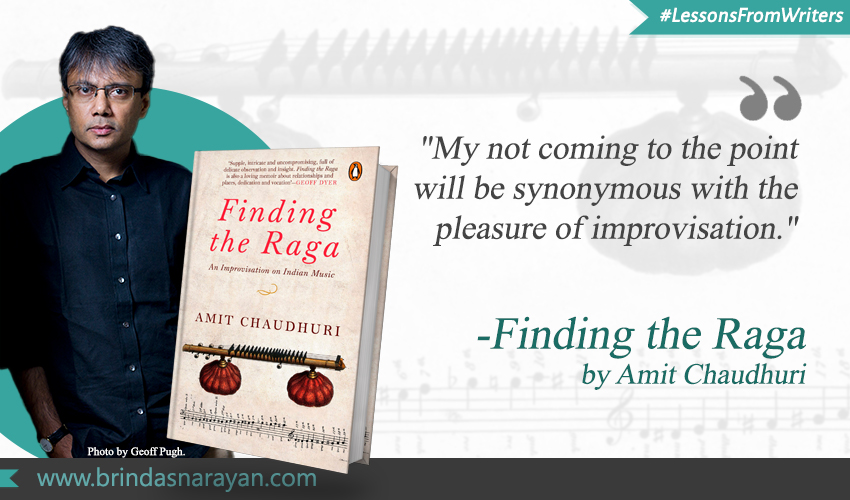
The Makings of a Musical Writer
As a writer, I have often dipped into the works of Amit Chaudhuri, as a masterclass in craft. His novels, stories and essays shimmer with images, the sort that Gustave Flaubert managed to evoke in Madame Bovary: with words that are supple, fluid, see-through. Mirroring a sheet of water, that ripples between a narrator’s interiority and the external world, with no rush at all. Not riverine, with sharp twists and bends; or even oceanic, with unforeseen tidal shifts. But like the still surface of a lake, beneath which flits a rich horde of colours and shapes.
More strikingly, his sentences have a quality that many writers strive for but fail to achieve: musicality. It’s unsurprising, when reading his latest nonfiction work, Finding the Raga, to discover that Chaudhuri was immersed in music, not just as a dilettante listener, but as a sincere practitioner.
His lessons in khayal – the form of Hindustani vocal music that has, for him, held a mesmeric appeal for many years – started out, like many adult learning journeys, with an adolescent’s unrest: “I think I was sixteen. I was acutely unhappy.” Growing up largely in Bombay, as the city was called then, he tried to fit into the culture of his hip cohort. By playing the guitar, writing songs, and vaguely mimicking Neil Young and Bob Dylan.
In the meanwhile, there were these other sounds echoing around his house. His mother, a talented and earnest singer, was taking Hindustani lessons from various masters. For many years, Chaudhari had been disdainful of this music, never seeing a future for himself in what felt like an unworthy and even reprehensible tradition.
But as Chaudhuri puts it, the self often acquires surprising contours: “What’s bored us might begin to obsess us.” This change was goaded by the arrival of a new music teacher: Govind Prasad Jaipurwale. Engaged to teach Chaudhuri’s mother, the teacher displayed an astonishing dexterity as he maneuvered his voice through a range of scales. An entranced Chaudhuri wanted to sing like that.
In his essay, “What is a Classic?” the South African author J.M.Coetzee recounts a similar encounter with Bach’s Well-Tempered Clavier. He was enthralled, frozen in place. But Coetzee wonders later if his rapture was partially driven by his need to subscribe to European codes or ‘high’ culture. Was his fascination an attempt to escape his origins and gain legitimacy in the colonizing culture?
In Chaudhuri’s case, his growing interest in Hindustani music wasn’t going to give him a leg-up among his peers. In fact, it would do the opposite: alienate him from the privileged, Anglophone set that inhabited his school and college. This wasn’t a rebellion then against his parents or roots, but a tugging away from surrounding expectations.
At this juncture, he also opted for other offbeat pathways. He dropped out of college entirely, and chose to homeschool himself with correspondence courses dispatched by Wolsey Hall, Oxford. And he spent many hours practicing his Hindustani vocal lessons.
Since then, he has held on to his riyaaz, even when he traveled later to England for higher education and work. He observes that one has to achieve a Goldilocks mean when it comes to riyaaz. If you over-practise you might damage your vocal chords. If you under-practise, the laxity will show through when you perform. Like physical workouts, regularity and consistency are key.
The Influence on his Writing
While Chaudhuri himself often resists the notion that his music influences his writing, he does acknowledge certain rub-offs.
Unwilling to submit to market strictures to drive pacy narratives, he has often deliberately lingered in extended beginnings or ‘alaaps’, without bothering to hasten towards a faster tempo. As he puts it, he has been content for his narrative to be comprised of a “series of opening paragraphs” – without propelling the story to expected middles or ends.
Moreover, the singing practice also exposed him to another language. Through khayals, he intimately encountered Avadhi – a form of Hindi spoken mostly in the Awadh region of Uttar Pradesh. When he started writing in Avadhi, it became a means of recovering his own history and an important dimension of his self. In Avadhi, Chaudhuri wrote as a woman. When writing in English, he wrote as a man. In Khudito Pashan, (The Hungry Stones), Tagore describes the transformation of Srijut, a tax collector, who dresses up like a Muslim aristocrat at night, shedding his day-time British self.
Till then, through his education and books, Chaudhuri had been of the view that one accumulates experiences in order to grow wiser. But with his practice of music and his immersion in a culture that had always surrounded him, but had eluded notice, he realized that ‘joy’ can be everywhere and anywhere. A narrative does not have to progress to an ending, but can linger joyfully as long as one wishes to in the alaap.
As Chaudhuri puts it, “My not coming to the point will be synonymous with the pleasure of improvisation.” As the narrator points out in one of his novels, “The ‘real’ story, with its beginning, middle and conclusion, would never be told, because it did not exist.”
References:
Amit Chaudhuri, Finding the Raga: An Improvisation on Indian Music, Penguin Random House India, 2021




